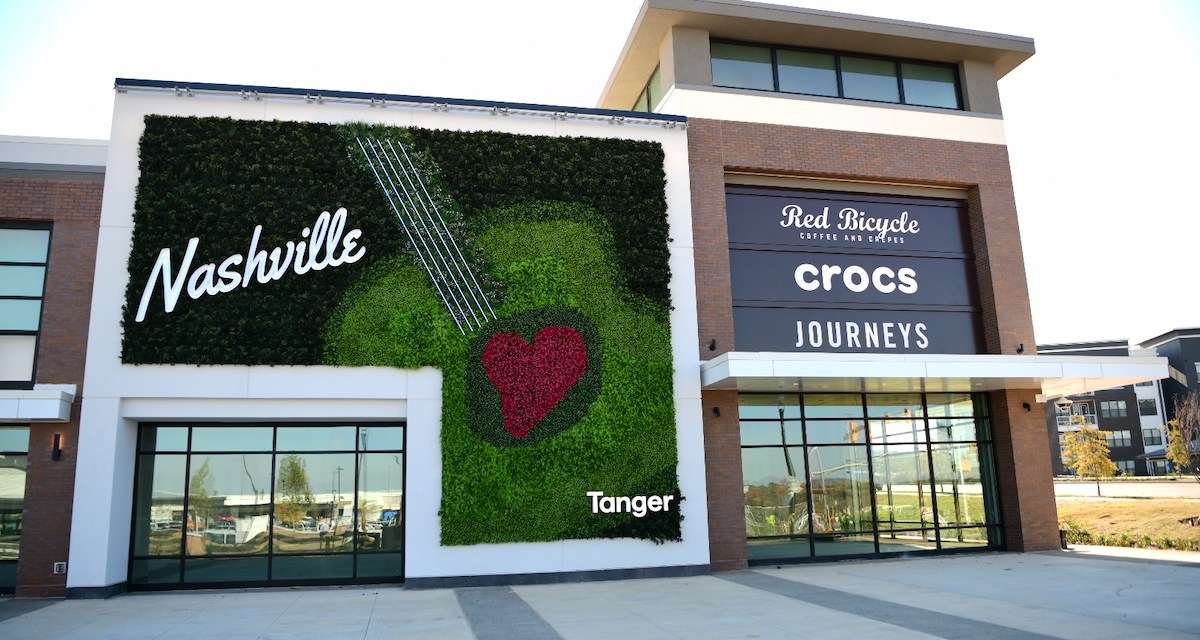‘We’re looking to grow our platform’: Why developers are opening more outlet centers

Mall developers are breaking ground on more outlet centers as demand for deals goes up.
Last month, Tanger Outlets opened a center in Nashville, Tennessee, its first such project to debut since the pandemic. The location, Tanger’s thirty-seventh, is already 96.5% leased, according to the company. Nearby, Simon Property Group — the largest owner of shopping malls in the United States — is building a Premium Outlet in Nashville, which it plans to open in 2024. Simon is also developing centers in Tulsa, Oklahoma and Carson, California and expanding its existing center in Woodbury, New York. Last month, it started construction on a center in Jakarta, Indonesia — its first Premium Outlet in the country.
While outlet malls have been around for years, they’ve become even more attractive to developers looking to make inroads with today’s more budget-cautious consumer. Outlet tenants typically provide discounts on merchandise, which help draw in a new segment of shoppers, one that may not want to pay full price. Retailers can also use outlet shops to offload excess merchandise or off-season inventory, further recouping money they might have lost.
In the past two weeks, Simon and Tanger both increased their full-year guidance for 2023, citing strong demand from brands and shoppers at malls and outlet centers. Speaking on an earnings call in October, David Simon, CEO of Simon Property Group, remarked that “base minimum rent levels are at record levels.” He continued, “We are very experienced at managing our business through volatile periods of time, and as you all know, this is when we do some of our best work.”
As outlet operators build more centers, retailers are snapping up existing space quickly. At the end of September, Simon’s outlets had an occupancy rate of 95.2%, compared to 94.5% from a year earlier. Tanger’s outlets had a 98% occupancy rate, up from 94.9% in June 2022. In fact, interest in Tanger’s new Nashville center was so strong that the company ended up turning businesses away, CEO Stephen Yalof told Modern Retail.
“We could have been 100% leased if we just leased to whoever raised their hand,” he said. “We knew our audience… and we wanted to make sure that we gave that group exactly what they were looking for.” Today, Tanger’s new Nashville outlet center has dozens of retailers — including local favorites like Red Bicycle Coffee and Prince’s Hot Chicken — and the company continues to “hold out for a few tenants” to fill in the correct gaps, according to Yalof.
In terms of a larger tenant mix, Tanger’s Nashville center is different from that of its existing centers. In the past, Yalof said, many of Tanger’s outlets belonged to the apparel and footwear business. Now, he said, “We’re finding a lot more cosmetics are getting into the business. Housewares and home are getting into the business in a much bigger way.” In addition, 7% to 8% of space in the Nashville center is dedicated to food and beverage companies. That number is 1% to 2% for other Tanger centers.
These changes largely stem from Covid-era shopping behaviors, Yalof pointed out. Before the pandemic, he said, customers looked for what he calls a “power shopping experience,” which involved moving from store to store and then leaving. During the pandemic, people desired a community space, Yalof said. “They didn’t want to just grab and go. They wanted to sit down and enjoy a meal. They wanted a place to enjoy entertainment.”
To that end, the Nashville center places a bigger emphasis on events and experiential retail. Its cooking stores hold cooking demonstrations, and brands like Nike host workout classes on “the Green,” an open space measuring half an acre in the middle of the center. The Green features a pavilion for performances, as well as a large screen to show football games and fashion shows. The Nashville center also features large-scale murals by 13 local and national artists.
Placer.ai, which tracks data from malls around the country, found that visits to outlet centers went up week-over-week from Sept. 5 to Oct. 1. Levels dropped off earlier in the summer, but over Labor Day weekend, the number of visitors to outlets jumped double digits and even sometimes triple digits over averages for days of the week that month.
Overall, “outlet centers have seen relatively strong visit rates compared to other mall formats in 2023,” Ethan Chernofsky, senior vice president of marketing at Placer.ai, told Modern Retail. And, especially because of their draw during the holidays, “there is ample reason to believe that these centers could show relative strength in the coming months,” he said.
Outlets are a popular draw for shoppers on a budget, and considering that inflation remains a concern, “there is little reason” to expect that outlets will lose their advantage in 2024, Chernofsky added. For outlets, he explained, “the key is to focus on the fundamentals.” “Is there an audience to be reached?” he asked. “What is the ideal mix of tenants to create a holistic experience? Centers that check these critical, foundational boxes are succeeding and will continue to succeed.”
Tanger, meanwhile, is invested in opening more outlets in the future, Yalof said, although the company has yet to make official announcements on where those will be. Still, he said, “We’re definitely in the market.”
“We’re looking to grow our platform,” Yalof said. “We’ve got a great team. We think we can handle a much larger footprint than the one that we have today. And we intend to continue to grow it.”

